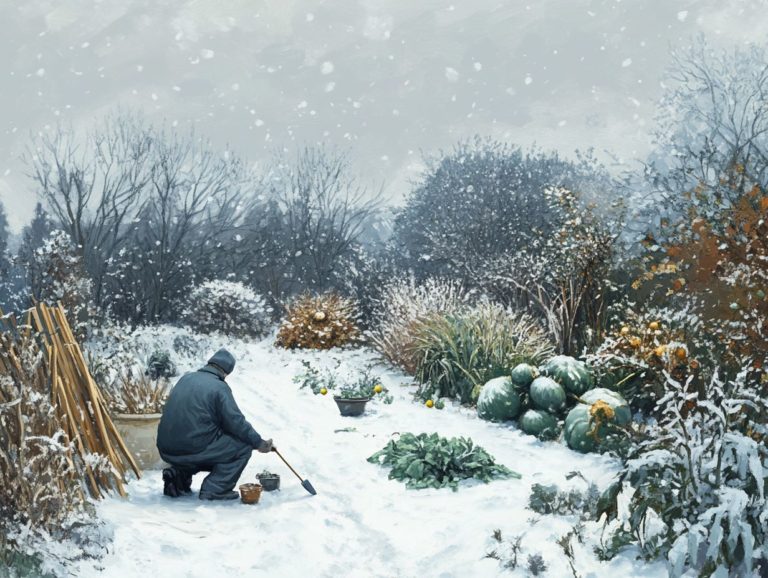5 Essential Tips for Winter Pest Monitoring
Winter is cozy, but pests can ruin that comfort. Don t let them in! As winter’s chill envelops your home, it’s easy to forget an unwelcome truth: pests can continue to thrive, even in the colder months.
This article presents five essential tips for effective winter pest monitoring. By inspecting potential entry points and maintaining a clutter-free environment, you can safeguard your home against unwanted visitors.
You’ll also discover common winter pests, the significance of regular pest control inspections, and effective sealing methods. Keep reading to ensure that your winter remains cozy and pest-free!
Contents
- Key Takeaways:
- 1. Inspect Your Home for Potential Entry Points
- 2. Store Firewood Away from Your Home
- 3. Keep Your Home Clean and Clutter-Free
- 4. Seal Cracks and Crevices
- 5. Schedule Regular Pest Control Inspections
- What Are the Most Common Winter Pests and How Can They Be Prevented?
- Frequently Asked Questions
- What are the 5 essential tips for winter pest monitoring?
- Why is it important to inspect your home regularly for pests during winter?
- How can sealing cracks and openings help with winter pest monitoring?
- What role does keeping your home clean and tidy play in winter pest monitoring?
- How should I store food to avoid attracting pests during winter?
- When should I contact a professional for winter pest monitoring?
Key Takeaways:

- Inspect your home regularly for potential entry points to prevent pests from getting inside.
- Store firewood away from your home to avoid attracting pests like termites and rodents.
- Keep your home clean and clutter-free to eliminate potential hiding spots for pests.
1. Inspect Your Home for Potential Entry Points
Be proactive this winter! It’s essential to inspect your home for potential entry points that pests like cockroaches, spiders, and rodents could exploit. Implementing the best practices for winter pest control can help prevent these intrusions, which, if left unchecked, can lead to significant property damage and health risks.
During this chilly season, even the tiniest cracks and openings can act as gateways for unwanted guests. Drafty windows, gaps in door frames, and small fissures in the foundation can allow pests to slip inside.
Working with pest control experts not only gives you an expert evaluation of these vulnerabilities but also helps you devise effective preventative strategies. For instance, learning about 5 techniques for winter pest management can be invaluable. Simple measures, such as sealing cracks and installing door sweeps, can keep your home cozy and pest-free throughout winter, ensuring that your family remains safe and comfortable during the colder months.
2. Store Firewood Away from Your Home
Storing firewood too close to your home can create a cozy invitation for winter pests like termites and spiders, significantly increasing the risk of health hazards and property damage.
To effectively mitigate these risks, it’s wise to keep your firewood at least 20 feet away from your home’s foundation. This distance not only discourages pests from making their way indoors but also encourages better airflow, allowing the wood to dry properly.
Regularly inspecting your stored firewood for signs of infestation such as young insects, bore holes, or webs can further enhance your home s safety. By adhering to these best practices in firewood storage, you can ensure a more enjoyable winter experience without the constant worry of unwelcome pests invading your space.
3. Keep Your Home Clean and Clutter-Free
Maintaining a clean and clutter-free home during winter is essential for preventing pest problems. A dirty environment can attract unwelcome visitors like cockroaches and spiders, which can pose health risks to your family.
To effectively combat these pests, it s crucial to establish a consistent cleaning routine that includes regular vacuuming, dusting, and sanitizing surfaces. Many people overlook the importance of safe food handling and disposal practices, but they are key to minimizing food waste that attracts pests.
An organized home not only enhances air quality but can also improve energy efficiency; for instance, cleaning vents and removing obstructions can help your heating system function better.
By integrating these cleaning and organizing strategies, you can create a healthier environment that safeguards your well-being while also reducing energy costs.
Take action now to keep your home cozy and free of pests this winter!
4. Seal Cracks and Crevices

Sealing cracks and crevices in your home is an essential step in pest-proofing. By effectively blocking entry points for winter pests, you re not just keeping the critters out; you re also enhancing your insulation and energy efficiency.
Regular maintenance is key to ensuring these barriers remain intact. This prevents pests from exploiting any vulnerabilities in your home s defenses.
You can use eco-friendly caulk made from natural materials or apply weather stripping around doors and windows. These sustainable options seal gaps and contribute to a healthier living environment.
Being proactive in identifying and sealing potential access points is crucial. This approach deters unwanted visitors and helps keep your home well-insulated. As a result, you lower energy costs and increase comfort.
5. Schedule Regular Pest Control Inspections
Scheduling regular pest control inspections during winter can greatly diminish the chance of infestations, safeguarding your home from potential damage caused by pests such as termites and rodents. Consider using these 5 tricks to keep pests away in winter for added protection.
By collaborating with professionals who specialize in pest management, you gain access to their expertise in pinpointing moisture sources and other factors that may attract unwanted guests. These specialists perform comprehensive assessments, providing you with valuable insights into any vulnerabilities in your home’s structure.
Early detection saves you from expensive repairs and reduces health risks linked to pests, ensuring you maintain a safe and comfortable living environment.
Routine inspections allow for timely interventions, enabling strategic treatments that fend off infestations and significantly enhance the overall longevity and integrity of your property.
What Are the Most Common Winter Pests and How Can They Be Prevented?
You must know the most common winter pests—think cockroaches, spiders, and termites. This knowledge is essential for you as a homeowner aiming to implement effective pest prevention strategies, including using essential traps for cold-weather pests and mitigate health risks during the colder months.
As the temperatures drop, these pests become increasingly active, seeking refuge indoors through the smallest of cracks and openings. Cockroaches thrive in warm, damp environments, often finding comfort in kitchens and bathrooms. Meanwhile, spiders tend to spin their webs in quiet corners and attics, taking full advantage of the lack of disturbance. Termites, on the other hand, have a penchant for wood or cellulose material, frequently nesting within walls or structural wood.
To keep infestations at bay, it s crucial for you to seal those entry points, maintain a clean living space, and conduct regular home inspections. When necessary, enlisting professional help can ensure that any pest problem is addressed effectively, allowing you to maintain a safe and comfortable living environment.
What Are the Benefits of Regular Pest Control Inspections?
Regular pest control inspections come with a wealth of advantages, not least of which is the early detection of infestations. This proactive approach can save you from costly property damage and minimize the health risks associated with pests.
These inspections do more than just spot existing pests; they also reveal moisture sources and entry points that could invite unwanted guests into your space. By identifying areas susceptible to dampness or structural weaknesses, you can take decisive action to eliminate these risks before they become problematic.
Pest control professionals are crucial for success. Their expertise allows them to implement targeted strategies that enhance both safety and comfort in your environment. This collaborative effort not only protects your property but also provides you with peace of mind, knowing that potential issues are being tackled before they spiral out of control.
How Can You Identify Potential Entry Points for Pests?

Identifying entry points for pests in your home requires a thorough inspection. Focus on cracks, openings around windows and doors, and other vulnerable spots that may welcome unwanted guests during winter.
Don’t forget to check less visible areas, such as the foundation, vents, and garages, where unnoticed gaps can form. The attic and crawl spaces often serve as secret highways for pests seeking warmth.
By checking these areas consistently, you can easily keep pests away! Fixing any vulnerabilities you find not only protects your home but also keeps your family healthy and comfortable during the colder months, especially with the right cold-weather pest management tools.
What Are the Best Methods for Sealing Cracks and Crevices?
The best methods for sealing cracks and crevices involve choosing good quality products that block pest entry points while enhancing your home’s insulation and energy efficiency.
Consider using sealing materials like caulk, expandable foam (a type of foam that grows to fill bigger gaps), and weather stripping. Each option has unique benefits for specific areas. For instance, caulk is great for small gaps around windows and doors, while expandable foam is ideal for larger openings, preventing both pests and air leaks. Weather stripping boosts insulation around doors, ensuring a comfortable indoor climate while keeping critters out.
Utilizing these techniques helps shield your home from pests and promotes a more energy-efficient living environment.
How Can You Keep Your Home Clean and Clutter-Free During Winter?
To maintain a clean and clutter-free home during winter, effective sanitation practices and regular decluttering can significantly reduce the risk of pest infestations.
As temperatures drop, focus on food storage; sealing food in airtight containers not only preserves freshness but also keeps pests away.
Dispose of garbage promptly and use sturdy trash bins with tight-fitting lids to minimize odors that attract rodents and insects.
Organize common areas and ensure items are stored properly to create a less inviting environment for pests.
Remember, a clean and tidy home with regular home maintenance is your strongest defense against pests. Consistent maintenance and organization can make a substantial difference!
What Are the Potential Risks of Neglecting Winter Pest Control?
Neglecting winter pest control can lead to serious consequences, including property damage and health risks from seasonal pest infestations like rodents and cockroaches.
Ignoring these pests allows them to multiply and increases the risk of structural damage as they chew through wires, insulation, and walls. Statistics show that nearly 30% of homes experience pest invasions during winter. You are not alone, and you must act fast!
For example, a family in a nearby neighborhood faced a staggering repair bill exceeding $10,000 after a mouse infestation damaged their home s wiring. This illustrates how quickly a minor oversight can escalate into a significant crisis. Don t wait! If you ignore pest control now, it could cost you later.
Frequently Asked Questions

What are the 5 essential tips for winter pest monitoring?
The 5 essential tips for winter pest monitoring are: 1) Inspect your home regularly; 2) Seal any cracks or openings; 3) Keep your home clean and tidy; 4) Store food properly; and 5) Follow the best practices for pest monitoring in winter by contacting professional services if needed.
Why is it important to inspect your home regularly for pests during winter?
Winter is a prime time for pests seeking shelter and warmth. Regular inspections help catch potential bug problems early and prevent them from spiraling out of control, especially if you follow these 5 steps for successful winter pest control.
How can sealing cracks and openings help with winter pest monitoring?
Pests can slip into your home through small cracks and openings. Sealing these entry points keeps them out, especially during winter when they look for warm hiding spots.
What role does keeping your home clean and tidy play in winter pest monitoring?
A clean home is less inviting to pests. Plus, it makes spotting any signs of bug activity easier.
How should I store food to avoid attracting pests during winter?
Pests are drawn to food, so store it in airtight containers. Clean up spills and crumbs promptly to make your home less appealing to them.
When should I contact a professional for winter pest monitoring?
If you see signs of pests or have an infestation you can’t handle, reach out to a professional pest control service. They have the tools and knowledge to manage pests effectively during winter.






